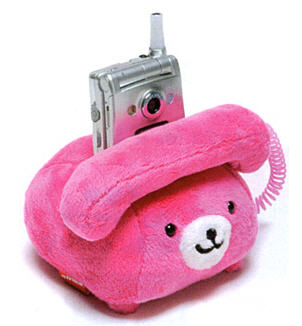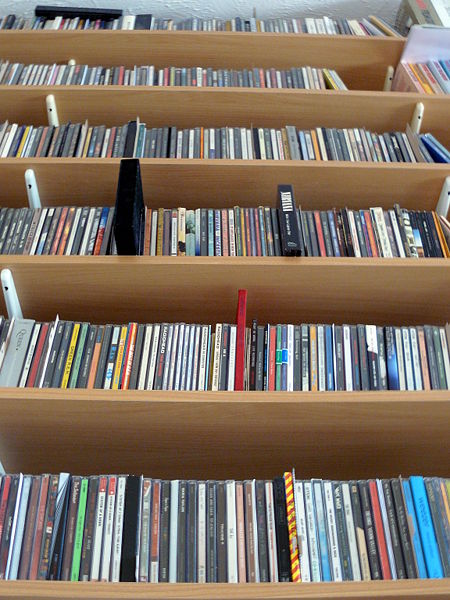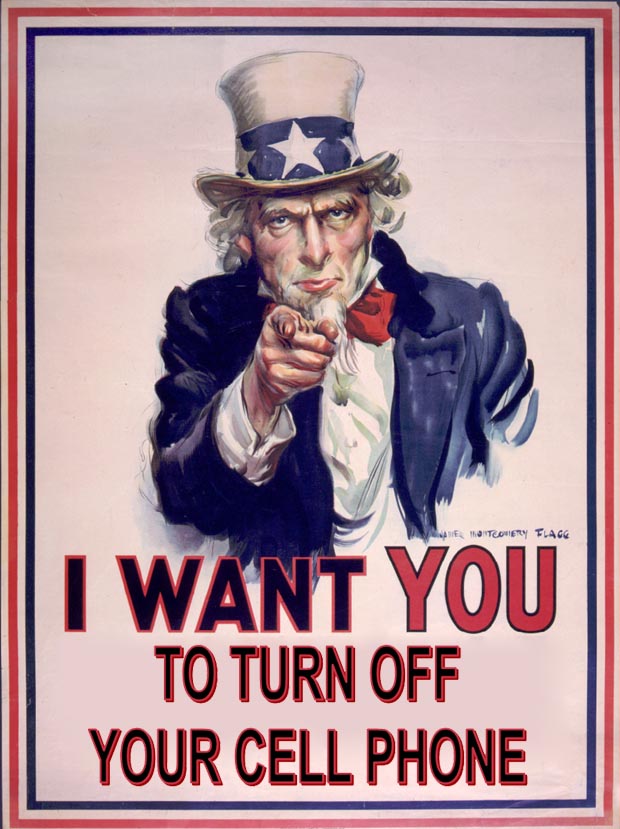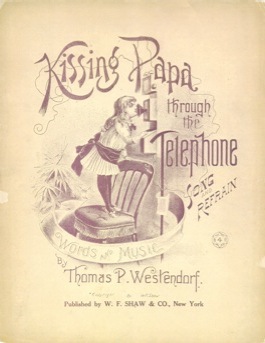Phonography: Lessons Learned from Teaching Audio Technologies
Lucas Hilderbrand / University of California, Irvine

Cellphone Cozy
In the fall, I taught one of my favorite courses, a small undergraduate lecture/discussion course on cultural studies of sound technologies and popular music.1 The goal of the course is to challenge students to think critically about the devices and acoustics they take for granted, such as telephones and portable music players, and to foster their analytical skills when listening to hip hop or watching videos or singing karaoke. Among my agendas for this course is to train them to think historically about what are, in the grand scheme of things, relatively recent innovations in sound recording and telecommunications. I had taught a version of the course once before, two year earlier. What struck me this time around was that it wasn’t just the students who needed to take the long view, but that I also needed to take a short view and recognize how quickly the uses and meanings of some technologies have shifted. I often identify as a proponent of old media, but I quickly came to recognize how differently students now relate to audio devices and aesthetics just two years later. Below, I offer some observations about what struck me as significant shifts in the ways undergraduates today understand the sonic scene.2

Tangible music collection
The students’ first writing assignment was a relatively basic one: chronicle the audio technologies they use and reflect upon how those devices or behaviors have changed over time. The two recurring comments that stood out among the papers both related to music and might be seen as effects of the fact that their consumption of music has been almost entirely during the period of peer-to-peer sharing and digital playlists. Keep in mind, Napster debuted more than a decade ago. (Feel free to feel old.) First, students no longer describe their music collections in terms of the number of CDs they own. Instead, they describe their music collections in terms of gigabytes. This suggests a shift in orientation away from albums as a unit of measurement, or even songs, which might make more sense in the age of single-song downloads. Instead, tracks have become largely disintegrated from albums when they have been downloaded, and students download a broad swath of music in a pattern of accumulation and grazing to see what they like. Their music libraries, then, are measured by how much memory their iPods need in order to make all the tracks accessible. This suggests to me a major reconceptualization of music as data, rather than music as the specific expression of particular artists or part of a larger coherent work. Secondarily, students reported having less of an investment in particular musicians because they tend to listen to different artists on a song-by-song basis. They may identify as fans of one or two groups, but by and large their tastes are vary between genres and performers—again an effect they attributed to downloading a large and largely undifferentiated mass of song files. I was also struck, the first day of class, that more students introduced themselves as liking Led Zeppelin than hip hop.

Cellphones off, please
In what is perhaps my most sadistic assignment, I asked my students to go 24 hours without using a phone for any purpose—not just talking and texting, but also using GPS or alarm clock or music player functions or any other apps. The students were required to write and reflect upon their deprivation, to interrogate what I presumed to be their dependence upon the technology as well as the ways not using the phone changed their sense of social relations and perceptions of time passing. I also gave the students a caveat, knowing some of them would fail the test: if they broke down and used their phones, interrogate why they felt it necessary. The biggest change from two years prior was that not only has texting replaced talking as the students’ primary communicative mode, but a surprising number of students said that they activity avoided talking to their friends. Almost every student claimed that cell phones made them feel “connected”—an abstraction that they all seemed reluctant to question—but they also indicated, paradoxically, that they no longer actually wanted to engage in conversation. Many of the students were given their first phones by their parents during middle school or high school so that the parents could always find out where they were; this kind of protective parenting seems to have created a culture wherein almost all the students continue to use their phones to call their parents every single day. (Call me old fashioned, but I thought part of the appeal of college was becoming an independent adult.) Some of the students expressed near-spiritual epiphanies by turning their phones off, but many more simply refused to experience disconnection. In one case, a student started his 24-hour experiment at the beginning of his Spanish class and made it all of 50 minutes before Googling a verb conjugation on his iPhone; in other words, he didn’t even make it through a single class period and didn’t try again.

Sheet music for “Kissing Papa Through the Telephone” (1898)
In my lecture about the cultural constructions of telephones, including their gendered connotations and the ways adoption deviated from their inventor’s imagined uses, I talk about early popular songs (and their sheet music illustrations) that attempted to narrate and make sense of telephones: the fantasmatic strangeness of hearing voices detached from bodies and the new romantic intimacies of sweet talk without chaperones. What is striking is that so much of recent music does much the same: popular songs regularly reference cell phones as part of our daily lives and romantic intrigues (or betrayals). For example, listen to Soulja Boy’s “Kiss Me Thru the Phone” or Lady Gaga and Beyoncé’s “Telephone.” In my favorite assignment for the class, students had to make mix CDs and write liner notes for tracks that commented upon audio technologies, the music industry, practices of listening, or self-reflexive musical form. (The first day, a student asked what liner notes were, further indicating a dissociation of music form tangible media and their paratexual elements such as album covers, printed lyrics, or production data.) The students found a number of songs that made connections between popular music forms and commentary on the sounds and technologies that pervade our world: from the obscure 1970s love song “Rings” by Lobo to Daft Punk’s commentary “Technologic” to Pogo’s hyper mixes of dialogue sampled from Disney films (my favorite being “Alice” with snippets of Alice in Wonderland) to Britney Spears’ catchy (though admittedly tacky) ode to aural sex, “Phonography.” The assignment not only forces the students to think differently about the music they already listen to, but it also gives me a sense of their listening tastes. One of the challenges of teaching popular culture, of course, is keeping up with the times and knowing which songs or TV shows or films actually resonate. In the age of downloading, YouTube, and hundreds of cable channels, it’s even more difficult to predict. But that’s part of the pleasure of teaching popular culture and new technologies.
[youtube]http://www.youtube.com/watch?v=yurekRbAyp4[/youtube]
Image Credits:
1. Cellphone cozy
2. Tangible music collection
3. Cellphones off, please
4. Sheet music for “Kissing Papa Through the Telephone” (1898)
Please feel free to comment.
- Course website available online at: https://eee.uci.edu/09f/26240/home.html [↩]
- Although the course’s appeal to audiophiles skewed enrollment just a bit to attract a few more straight white male students than I typically have, the class of 35 students had an even gender balance and a diverse mix of white, Asian/Asian-American, and Latino students. UC Irvine is by far the most diverse university at which I have taught. [↩]
I definitely agree with you on the demise of the album as the unit measurement of a music collection. But I’m surprised these students have taken it as far as measuring by the number of GBs. Personally, I still measure my music by the number of songs, as that feels like a more concrete number considering the varying sizes of song files (dependent on length of a song and the sound quality).
As a music prof at Irvine, I find this fascinating; most of us still wrestle with whether we should music as an abstract score, a performance, or an audio object, but I never thought the experience of music fandom would be reduced to GB (minutes or hours would make more sense, but require at least a minimum of reflective thought to determine).